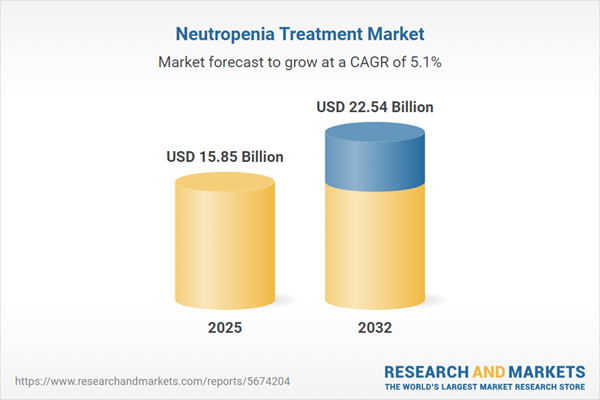Speak directly to the analyst to clarify any post sales queries you may have.
The neutropenia treatment market is undergoing rapid change as healthcare systems demand more adaptive, patient-focused solutions to address the risks and treatment challenges facing oncology patients. This report equips senior decision-makers with data-driven insights to navigate evolving clinical pathways, pricing pressures, and strategic partnerships across the global landscape.
Market Snapshot: Neutropenia Treatment Market Size and Growth Outlook
The neutropenia treatment market grew from USD 15.08 billion in 2024 to USD 15.85 billion in 2025. It is expected to maintain strong momentum, projected to reach USD 22.54 billion by 2032, supported by a compound annual growth rate (CAGR) of 5.14%.
Scope & Segmentation
- Treatment Type: Filgrastim (300 mcg, 480 mcg, 600 mcg), Lenograstim (3 mg, 5 mg), Pegfilgrastim (6 mg)
- Therapy Class: Biosimilar, Originator
- Route of Administration: Intravenous Injection, Subcutaneous Injection
- Distribution Channel: Hospital Pharmacy (Inpatient, Outpatient), Online Pharmacy, Retail Pharmacy (Chain, Independent)
- End User: Ambulatory Care Centers, Clinics, Home Care, Hospitals (Private, Public)
- Patient Age Group: Adult, Geriatric, Pediatric
- Severity: Mild, Moderate, Severe
- Geographic Focus: Americas (North America: United States, Canada, Mexico; Latin America: Brazil, Argentina, Chile, Colombia, Peru), Europe, Middle East & Africa (e.g., United Kingdom, Germany, France, Middle East countries, Sub-Saharan Africa), Asia-Pacific (China, India, Japan, Australia, South Korea, Southeast Asian countries)
- Featured Companies: Amgen Inc., Sandoz International GmbH, Pfizer Inc., Teva Pharmaceutical Industries Ltd., Viatris Inc., Coherus BioSciences, Inc., Fresenius Kabi AG, Intas Pharmaceuticals Ltd., Biocon Limited, Celltrion, Inc.
Key Takeaways for Senior Decision-Makers
- Advances in biologics, biosimilars, and administration techniques are reshaping the clinical landscape and shifting market preferences, with clear implications for procurement and lifecycle management strategies.
- Personalized neutropenia management is gaining traction, balancing patient safety and convenience while prompting a reevaluation of standardized dosing and care protocols.
- Increasing adoption of digital health tools is enabling real-time monitoring, driving proactive interventions, and supporting value-based care initiatives.
- The competitive environment is defined by strategic alliances, technology transfer, and shared distribution networks that broaden product reach in both established and emerging markets.
- End-user diversity—from hospitals to ambulatory and home care—demands targeted solutions and flexible supply models to address unique tolerability and care delivery needs.
Tariff Impact: Navigating Supply Chain and Pricing Volatility
Tariff adjustments in the United States for 2025 are set to create ripple effects throughout the neutropenia treatment supply chain. As levies on biologic intermediates increase, pharmaceutical manufacturers may revisit sourcing and localization strategies to contain rising costs. Downstream, hospitals and specialty pharmacies are likely to experience budget pressures, leading to renewed interest in supply chain optimization, alternate sourcing, and collaborative purchasing frameworks. Proactive scenario planning and agile risk management will be critical to maintaining patient access to essential therapies.
Methodology & Data Sources
This report employs a dual approach—conducting expert interviews with hematologists, oncologists, and clinical pharmacists, combined with targeted surveys to hospital pharmacy directors and specialty pharmacy managers. Secondary sources include regulatory filings, industry presentations, and peer-reviewed literature, with triangulation and regular audits to ensure insight reliability and market credibility.
Why This Report Matters: Strategic Value for Decision-Makers
- Enables informed planning by clarifying differentiation opportunities across patient segments, care settings, and geographies.
- Equips stakeholders to anticipate and adapt to supply chain and regulatory disruptions in an increasingly complex environment.
- Supports effective alignment between clinical, operational, and procurement priorities to sustain competitive advantage.
Conclusion
With new therapies, digital solutions, and evolving care models converging, the neutropenia treatment segment offers dynamic growth opportunities. Strategic adaptation—rooted in data and collaborative innovation—will be essential for leaders seeking to advance patient outcomes and operational efficiency.
Additional Product Information:
- Purchase of this report includes 1 year online access with quarterly updates.
- This report can be updated on request. Please contact our Customer Experience team using the Ask a Question widget on our website.
Table of Contents
3. Executive Summary
4. Market Overview
7. Cumulative Impact of Artificial Intelligence 2025
List of Figures
Samples

LOADING...
Companies Mentioned
The key companies profiled in this Neutropenia Treatment market report include:- Amgen Inc.
- Sandoz International GmbH
- Pfizer Inc.
- Teva Pharmaceutical Industries Ltd.
- Viatris Inc.
- Coherus BioSciences, Inc.
- Fresenius Kabi AG
- Intas Pharmaceuticals Ltd.
- Biocon Limited
- Celltrion, Inc.
Table Information
| Report Attribute | Details |
|---|---|
| No. of Pages | 182 |
| Published | October 2025 |
| Forecast Period | 2025 - 2032 |
| Estimated Market Value ( USD | $ 15.85 Billion |
| Forecasted Market Value ( USD | $ 22.54 Billion |
| Compound Annual Growth Rate | 5.1% |
| Regions Covered | Global |
| No. of Companies Mentioned | 11 |









